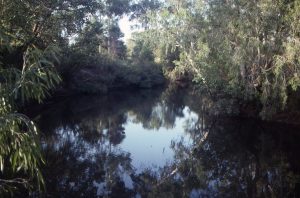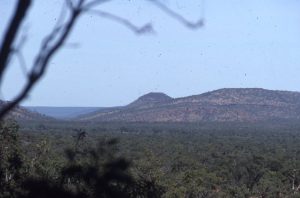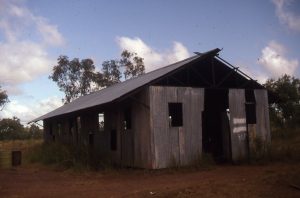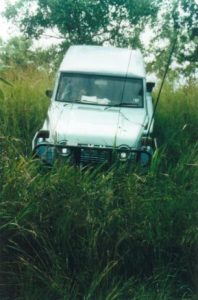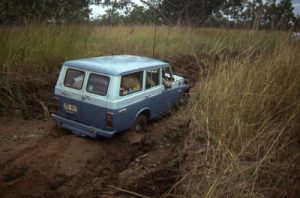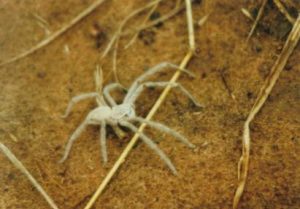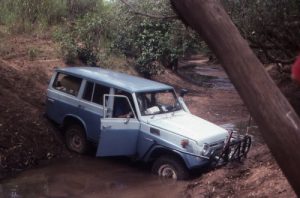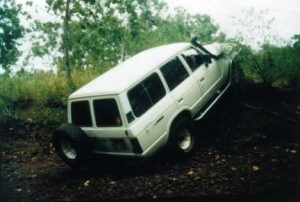Published in 4×4 Australia Magazine August 1992. Some photo updates 2011
Back up! Back up! I called to my mates on the radio. Once again we had come to a creek at a point that was impossible to cross. I got out of the vehicle and walked through the six feet high spear grass to find a suitable crossing place. During our ten day adventure into this remote part of the Northern Territory we crossed no less than 90 creeks and washouts.
Judith and I in our FJ55, together with friends George, Maureen and young Christopher in their HJ60 and Milton and Ruth and ‘Puppy’ in their FJ47 set off on a ten day exploration holiday that would cure us of four wheel driving for a while.
These days, with costs running sky high on everything, one can barely scrape the money together to go on a camping trip every three months let alone every other weekend. Gone are the days of the 2 stroke Suzuki when you could go bush for $50 for a weekend.
This trip was six months in the planning. I obtained permission from Tac Hall, owner of Innesvale Station and Ian McBean, owner of Bradshaw Station, for the purposes of camping and having a look around. Tac Hall is considering supplementing his cattle business with a tourism venture and I understand from local sources that a tour operator is going to run tours into Bradshaw Station in the near future. Well, I hope that the latter has plenty of stamina and plenty of winch cable because where we went was hard going all the way. Ian McBean commented that the area we were going into had not been mustered for ten years as the terrain was too rough.
Yambarran Valley
We left the bitumen 24km south of Pine Creek, passed through Claravale Station and Dorisvale Station along a public road, crossing the Daly River and travelling on to Wombungi Outstation where we were to begin our trip along Palm Creek. Although we had had a poor wet season this past year there had been enough rain to make the floodplains wet and boggy and the tall spear grass ten feet high in places. Palm Creek is a major tributary of the Fitzmaurice River and joins the Fitzmaurice in a long floodplain basin, and flanked either side by a 250 metre high escarpment. The floodplain is 15km wide and 40km in length. My 1:50,000 Australian Survey maps showed a track that followed the escarpment to the north and crossing over the floodplain just west of the junction of Palm Creek and the Fitzmaurice River. The track, shown in dotted line format also has ‘Approximate Position’ written next to it. According to Ian McBean it was doubtful if that track was still in existence.
George had borrowed a Sony Pyxus GPS from a mate to try out. At $2000 each, this equipment is still very new on the market and now comes in hand held form. Hopefully prices will drop in the future. Previous models were cumbersome boxes. We took numerous readings whilst we were on our holiday and it proved to be invaluable to pin-point a position to within 100 meters.
In the afternoon, whilst driving west into the sun, I got snagged up on a large piece of no.9 fencing wire in a rather damp area. It took more than an hour to cut away the wire which had wrapped around the axles and springs and we decided to call it quits for the day and camp. We backtracked to the Wombungi Road and camped on a running creek near the abandoned outstation for the night.
In the morning we ascertained that the floodplain was too wet to cross and we made for the hilly country on the fringes of the northern escarpment. I pointed the FJ55 into the tall grass and made for the nearest rise. It was hard going, bouncing over rocks and crawling up and down some very steep hills. We had to cross over a number of small creeks that run out of the escarpment and we were driving ‘blind’ through the tall grass in the gullies. On a couple of occasions I made it 90% to the top of the hill only to lose traction and then having to reverse down the steep incline, being aware that if the vehicle slid sideways, a roll over was possible. All the gear in the vehicle blocked the back vision and I had to be directed down by the vehicle behind me. I reversed into two trees doing this. My little mate sitting next to me was not amused and opted to get out and walk at the first sign of danger.
By the end of the day we had driven 14km but had gained only 5km in real distance. Once out of the hills and on higher ground I felt that my power steering was acting contrary to normal. On inspection it revealed that the tie rod was bent right up against the sump. With the help of Miltons’ PTO winch and a sizeable log we soon straightened the tie rod. It was time to camp.
On the third day we drove off on a north-west bearing across the plains in search of the track. The first challenge of the day came when I entered a four metre deep dry creek. The sides of the embankment were dry and brittle and the weight of the vehicle broke the surface and made a slide into the creek bed. But it was so steep that I slid off the seat. The bulbar, with a low slung protector bar at the bottom, dug into the soft creek sand as I pushed forward ever so gently. Halfway through this descent I had to turn to the left and then as the vehicle came into the creek bed, gun the accelerator so as to get enough momentum to clear the embankment on the other side. By the time the last vehicle came through the driver asked what the fuss was about as it was an easy track. Many of the following creeks that we had to cross were of this nature and it was slow going. Just ease her down.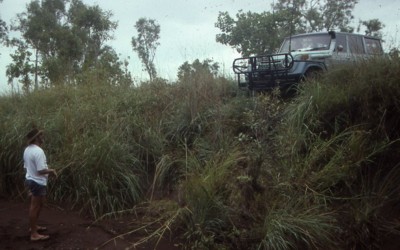
About mid morning we came across the track after hours of straining ones neck in the tall grass. According to the GPS the track was 1km out of line with the map. Suddenly we were back in High Range again and speeding along at 20kmh. The track was very faint and could only be found at times by looking for the windrow made by the grader blade sone seven years prior. The grass was still over the top of the bull bar in places and more times than I like to recall I had to say ‘Back Up, Back Up’ on the radio and go in search of a presentable creek crossing. George got the HJ60 hung up in a creek and had to use the Warn 8000 and a snatch block to extricate himself. The 8000lb winches just seem a tad too light for the heavy Landcruisers and almost every time that you have to use the winch you need to use the snatch block as well.
Then I entered a creek bed that looked dry but was in actual fact an underground creek. Once the FJ55 had broken the surface it was pure ooze beneath and we settled in the mud right down to the chassis rails. Milton and George found a dry crossing and with all three winches working in unison with snatch blocks and about 36000lb pull we managed to get the old girl out of the mire. Mind you we also had to do some excavation work on the opposite embankment and the vehicle was being pulled into the bank instead of up and over. Two hours later we were moving again.
A Barking Spider entertained us for a while as somehow it had entered the vehicle and was walking towards us along the hood lining. There was a general “abandon ship” cry as we flung ourselves from the car. With great difficulty we coaxed the spider out of the car and into the scrub.
That night we camped in ‘Old Fella’ Gorge, a name that I gave, after some of the erotic aboriginal paintings under the overhangs along the escarpment. This gorge is seven kilometres long and has high cliffs of red sandstone. We camped there for three nights getting back our strength and exploring our surroundings. Apart from feral donkeys, one feral cat and the odd dingo or two we were conscious of the absence of kangaroos, wallabies and feral pigs. There were no signs of any cattle inhabiting the area at all. We did see rock wallaby droppings in the escarpment but those shy animals kept a low profile and out of our sight. Bird life was prolific as usual.
We followed the faint track south from the escarpment and crossed the Fitzmaurice River, downstream from the junction with Palm Creek. The river was flowing but was not very deep. Both embankments were steep however and it was another winch job which took more than two hours to get the three vehicles to the other side.
I had seen a spot of greenery on the southern escarpment from a distance. Our faint track veered away from this place so I swung the nose around and off the track and went bush heading for the green. On approaching the small tropical rainforest I got hung up on some rocks and had to be winched backwards as moving forward was not an option. This small rainforest pocket had a natural clearing right in the middle and made an ideal camp site and we were able to take all three vehicles in without damaging any of the foliage. We named our camp Water Snake Springs as young Christopher discovered the reptile. We checked our reference library and the snake turned out to be a Macleay’s Water Snake and quite harmless. Later we were to take photos of the snake and its partner. They were quite unperturbed by our presence. One night we had a visitation from a Brown Tree Snake which leapt from one branch to another. We also had a visit from the biggest Perentie lizard any of us had ever seen. It strolled around our camp with disdain using its tongue to sniff out any possible delicacies. In the end we had to make a loud noise to scare it away as it came too close to our food supply. We were protected from the harsh sun by the rain forest canopy and just thirty metres away there was a lovely swimming hole which was fed by the spring. We could all fit in the water hole at once and enjoyed many relaxing hours there.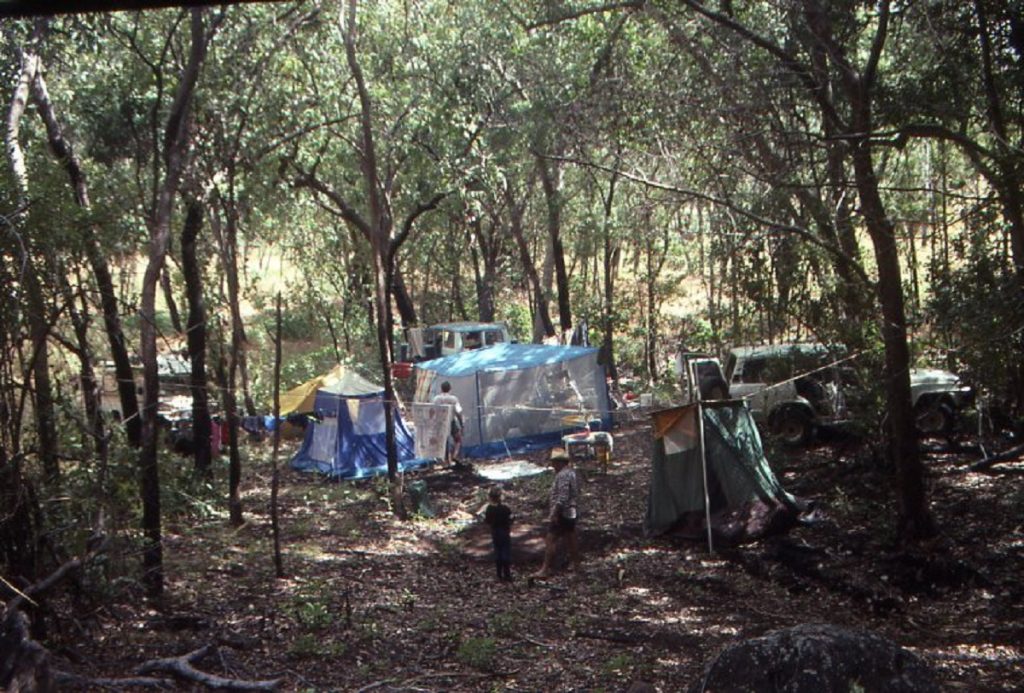
Water-snake Camp
Before we left this idyllic campsite we went exploring and drove west along this escarpment and entered a very large gorge. This was a boy’s trip while the girls stayed at the camp and baked bread and other treats. We drove up the gorge for a little way and then walked about 2 kilometres. Found some good aboriginal rock paintings and a nice swimming hole. It was very hard going though as the grass was very thick in places. On the way back to camp I hit another hidden stump and it was time to straighten the tie rod again. This time I used my own winch via a snatch block attached to Milton’s truck.
On Easter Sunday we started making our way back to Wombungi. Driving cross country again, George split one of his wide tyres. And the spare was also flat. So we had to pump the fresh tyre up after fitting a tube. It was there that we discovered that all three air pumps were not working properly and we had to take one apart and repair it. Lesson learned. Service your air pump regularly. Luckily George had the presence of mind to have his puncture in the shade of a nice big tree so that we could stay cool.
We were still looking for the mustering track when I came across a boggy gully. After a cursory look I decided to cross over. That was a mistake. The front wheels dropped right down into the mud while the back wheels got hung up on a ledge. At the same time the positive cable to the winch had rubbed through its rubber coating on the chassis causing a dead short and draining the battery within seconds.
It was another winch job as a snatch strap proved to be ineffective. While everyone was standing about giving advice I sent the girls on a mission to find a suitable place to cross. It was not long before they returned excitedly claiming to have found the lost track. And there it was, just 100 metres away from my bog hole. Once I was mobile again after some temporary repairs and a jump start we were on our way.
The track was very faint in places and it was slow going and I got bogged in a swamp and had to be winched out again. We crossed several very deep creeks and not without some minor panel damage before finding Palm Creek again. It was time to camp. The blokes tried their hand at fishing and landed 3 bream, 2 catfish and a Saratoga in a short time. A cheeky goanna came along and tried to knock off some of the fish. Palm Creek also gave up some lovely quartz crystals and each vehicle left with added weight. By this time the flies were annoying us intensely. They say that out in the Australian bush the best time of day is that half hour between when the flies go to sleep and the mosquitoes come out to annoy you. The mozzies annoyed us to no end and we were forced to put up the tent.
On our last day, we had a 14km drive to get back to where we had left the station road and another 400km back to Darwin. We crossed seven creeks on the way out, some with difficulty and lost the track more than once.
Back on the Wombungi Outstation road it was time to de-grass the radiator guards. The quickest way to do this is that after you have removed the grille and the gauze, you pull any exposed wiring out of the way and put a match to any grass that has found its way through the guard. The grass burns quickly with a ‘whoosh’ and presto!! You have a clean radiator. Normally the air-conditioning radiator cops all the grass and saves the vehicles cooling system from clogging up.
It had been a good holiday with plenty of four wheeling and a relaxing time out in the bush.

